Sympathetic Vibration
Prolongation of sound by reflection
This paper was originally presented at the Toronto Electroacoustic Symposium 2008 (7–9 August 2008).
The idea is not to try and create something completely new, but to enlighten some fading practices.

Introduction
Timing is everything. I remember sitting in the Quad at York St John University on a very cold day early 2007, chatting to a colleague about how sound differs in the same space at different times in the year. I have been obsessed with the sound of these subtle little performances for many years and I can only be an active listener for a short period of time before the desire to record takes over.
The campus itself is approximately forty thousand square meters, set in the heart of the Roman City of York, overlooked by York Minster and Roman walls, with a wealth of sounds presenting themselves throughout the entire day, from traffic sounds to hordes of tourists flocking all year round.
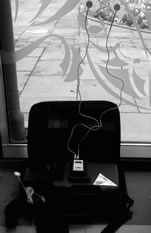
Sympathetic Vibration
I began collecting sound in Spring 2007, wandering around campus armed with a number of small recording devices, recording the most noticeable sounds I could possibly hear. Once I started to playback the sounds, I found myself gravitating towards the smaller sounds or those that might otherwise be overlooked i.e. the faint sound of the electricity in the wall, the water running through the pipes etc. I shortly returned armed with a number of contact microphones (Fig. 1), this enabled me to attach devices to the walls, windows, pipes and just about anything else I could lay my hands on, picking up every possible microscopic sound. In addition to microphones I used an electromagnetic coil (Fig. 2) to collect sound though electronic frequencies emanating from such devices such as mobile phones and radio microphones, and from locations containing multiple electronic devices, i.e. an IT room. I managed to pick up little sections of slightly distorted conversation between the staff and students.
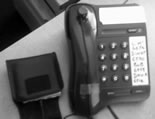
Extensions to project
Later that year, during the summer months, I managed to sweet talk several members of staff into being a part of the Internal Broadcast project. The idea behind the project was to record a day in a life of an internal mail envelope (Fig. 3). I inserted a very small microphone into an envelope for those lovely people to carry around with them wherever they went (yes even the toilet in some cases!), passing on the envelope every 30–40 minutes, recording their every move.
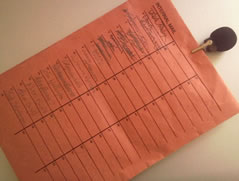
In another attempt to capture as much information as possible, I interviewed a number of students and members of staff, asking key questions about their own personal experiences whilst at York St John University and how the sound they hear can affect them. The results were varied, with people commenting on the sounds heard whilst walking through the Quad, the sounds of birds nesting, of traffic passing along Lord Mayor’s Walk, and the sound of countless different accents from around the world. Once I had collected what I thought was enough information, I dissected each fragment of conversation, taking the highlights and most interesting aspects.
Soundwalk
One of the fundamental aims of the project was to assist both staff and students who are visually impaired, aiding them by using sound to identify their location. Having little knowledge of what it might be like to walk around the campus without the benefit of sight, I contacted a visually impaired student, who kindly explained that he felt vision was possibly overrated and hearing overlooked. The idea was then to develop a soundwalk across campus (Fig. 4), mark out a route, and walk around using a binaural microphone. The binaural microphone (Fig. 5) gives a realistic representation of what we hear and how we hear it, factoring in the natural sonic shaping of the head and ears. When listening to these particular recordings, it is important that you listen to them through headphones to achieve the binaural effect. I lettered each section so that the listener could choose their own personal course, whether listening to the route on-line or dropping each sound-snippet into their own MP3 player.
Light Reader
Obviously we hear different sounds each day at different times in the year. Clearly the same could be said about the things we see. A telescope was used to collect light from around the campus, and photoelectric sensors (Fig. 6) were attached to audio cable, translating discrete light sources into sound. Light samples were collected from inside particular rooms, and also from external parts of the campus. I found that this method was much more successful at night, recording the lights in the building as they were turned on and off, emitting small pulses of sound which varied in both tone and pitch.

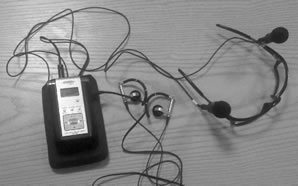
Conclusion
I had always had an idea of what the final pieces would sound like, and worked towards capturing the activation within the space in ways that shift focus away from the apparent, using a mixture of field recordings and lo-tech electronics. One thing I always tried to be aware of was the fact that the project would have little meaning without listeners. Considering the immediate audience was potentially 6000 students and 500 staff, the involvement of both throughout the project was key to the final outcome.
Main Ingredients
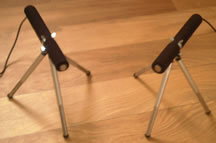
Contact microphone. Flat piezo disks you can attach to walls, window, doors, pipes and even people assuming they stand still for long enough.
Electromagnetic coil. a conductor (usually a solid copper wire) is wound around a core to create an inductor. It acts a little like a radio antenna, picking up electromagnetic frequencies e.g. radio microphone, mobile phones etc…
Photoelectric sensors / photo cells. These are essentially mini electronic devices that allows light to travel through them, producing a small current, which in turn produces a kind of ’sparkly drone” like sound, depending the types of light in use.
Binaural microphone. Two small microphones that you attach one to each side of the head or one in each ear, depending on the type you use.
Acknowledgements
I’d like to thank all people involved in the interviews and the internal mail project, in particular Andrew Merrison for making me laugh, Chris Boyes for his constant enthusiasm and Audrey Layton for always saying yes.
The support of C4C and TechDIS, without whom the project may not have been possible and finally to all the people who didn’t mind me recording their every move for several months.
Social top